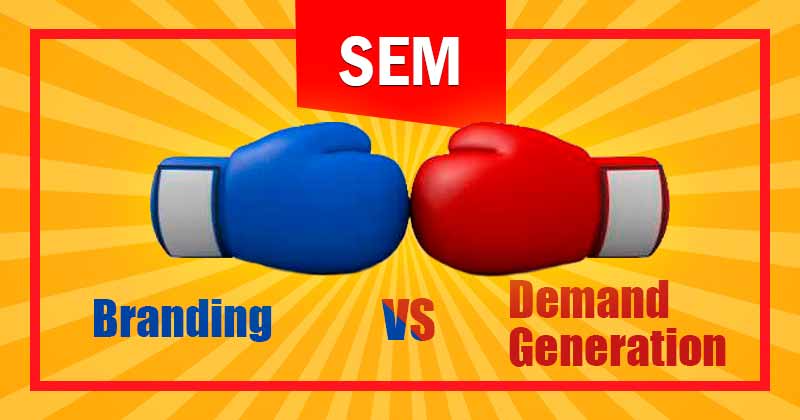SEM Ads: Branding vs. Demand Generation

Branding: This strategy is about defining your place in the minds of your consumers, and letting them know that you exist.
You cannot sell products or services to people if they don’t know that you exist and what you do. Unlike demand-generation, with branding there is no direct connection between it and sales though there is an indirect link. Think of radio or tv commercials or ads in a magazine. These would be considered branding strategies unless you included a 1-800 number with a special deal to buy (think infomercial). Considering that SEM ads only appear after a user indicates his or her interest, there’s an argument to be made that SEM ads are less appropriate for branding or awareness projects since the user is already clearly aware if he or she is searching for you.
Demand-Generation: This is all about identifying opportunities to sell your product or service. Demand takes the form of a lead or a direct connection to a sale contributing in a traceable way to revenue. In some companies, such as many B2C companies, it’s a quick result, while for companies that sell more expensive products or services or are B2B, there’s a longer time-to-purchase.
Demand-generation strategies have an element of branding to them, as there might be X amount of impressions before X amount of leads, and there are instances where a person sees one ad and calls up a company to buy the product. What really differentiates these strategies is your intended goal—awareness or leads.
But what about SEM?
In their own ways, both strategies can be effective for SEM.
If you’re using SEM for branding purposes, the goal is often to dominate a particular topic or keyword, in which case, a company might set up a campaign with targets based on available impression share for the keyword (available impression share is a metric that shows how many times your ad showed in the results when that keyword was searched and you were eligible).
So, if you’re a cola company your goal could be to get 80% of the available impression share for your topic or keyword. However, dominating a popular keyword can be expensive. Many companies instead focus on a branding strategy regarding their own brand, which may seem counterintuitive (we already appear in the top search results when you type in our name) but at the very least, it helps to keep your competitors from appearing as often for your brand. It’s also relatively inexpensive because you tend to have a strong quality score for your own brand.
Now, with a demand-generation strategy, you have a cost per conversion price point in mind, or better yet a profit point, and success is measured by the number of conversions rather than the number of ad impressions. For example, let’s say a company wants people to sign up for a free trial of its software, so the strategy would be to have ads that bring users to a landing page, which then asks them to sign up for a free trial. If you know that for every 5 trial signups, you get one paying customer worth $100 in revenue, you might be willing to pay up to $99 to capture 5 trials.
Branding campaigns are more of a long term strategy where demand-generation is more about immediate, measurable results. You may use a branding campaign to build a list of qualified prospects whom you want to reach again through remarketing. Then, with your list in hand you could run a demand generation campaign for those propects.
So, is one strategy better than the other? They both have their merits. But with a branding strategy, you’ll need to ensure you have deep pockets, as it will get expensive. Whereas with a demand-generation strategy you should be able to adjust all the variables available to you – geo, time of day, demographics, etc – to ensure your ad budget achieves the necessary return on ad spend.
Want to know more about SEM? Read some of our other blog posts:
How to Use Online Reviews for Paid Search
What’s the Buzz About Voice Search?
Do I Need to be Worried About Click Fraud?
Bing’s Basket of Deplorables
